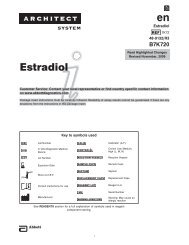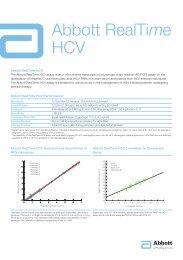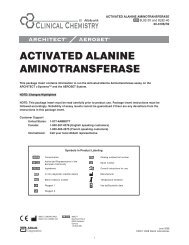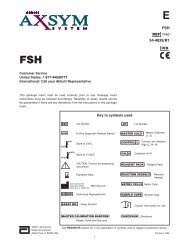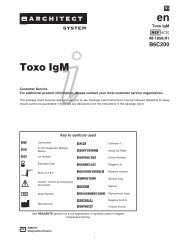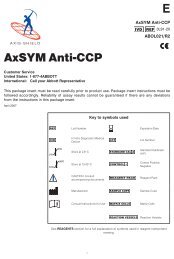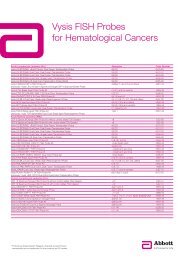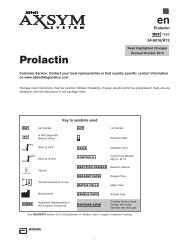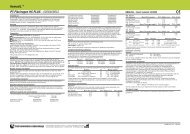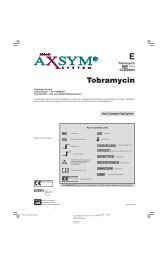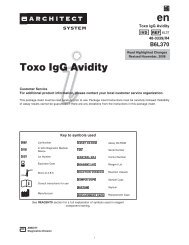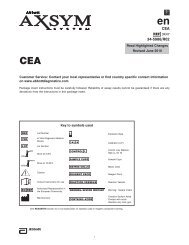LDH - ILEX Medical Systems
LDH - ILEX Medical Systems
LDH - ILEX Medical Systems
Create successful ePaper yourself
Turn your PDF publications into a flip-book with our unique Google optimized e-Paper software.
LACTATE DEHYDROGENASE7D69-2030-3133/R4LACTATEDEHYDROGENASEThis package insert contains information to run the Lactate Dehydrogenase assay on the ARCHITECT c <strong>Systems</strong>and the AEROSET System.NOTE: Changes HighlightedNOTE: This package insert must be read carefully prior to product use. Package insert instructions must be followedaccordingly. Reliability of assay results cannot be guaranteed if there are any deviations from the instructions inthis package insert.Customer SupportUnited States:Canada:International:1-877-4ABBOTT1-800-387-8378 (English speaking customers)1-800-465-2675 (French speaking customers)Call your local Abbott representativeSymbols in Product LabelingConcentrationAuthorized Representative in theEuropean CommunityIngredientsIn vitro diagnostic medical deviceBatch code/Lot numberReagent 1Catalog number/List numberSerial numberConsult instructions for useManufacturerTemperature limitationUse by/Expiration dateReagent 2ABBOTT LABORATORIESAbbott Park, IL 60064, USAABBOTTMax-Planck-Ring 265205 WiesbadenGermany+49-6122-580October 2006©2002, 2006 Abbott Laboratories1
NAMELACTATE DEHYDROGENASEINTENDED USEThe Lactate Dehydrogenase (LD) assay is used for the quantitation oflactate dehydrogenase in human serum or plasma.SUMMARY AND EXPLANATION OF TESTLactate dehydrogenase (LD) is an enzyme which can be found in mostmajor tissues. Serum levels of LD are elevated in a wide variety ofpathologic conditions, most notably cardiac and hepatic disease. LD isa tetrameric enzyme consisting of two basic subunits. Five isoenzymescan be observed after electrophoresis. The relative ratios of theisoenzymes vary with the tissue source of the LD. 1PRINCIPLES OF PROCEDURELD catalyzes the conversion of lactate to pyruvate, the forward reactionand the conversion of pyruvate to lactate, the reverse reaction. Theenzyme may be assayed using either material as a substrate; however,the enzyme activities obtained by the two methods are not directlycomparable. The forward reaction does not require preincubation toexhaust endogenous α-keto acids and displays linearity over a widerrange of activity in patient samples. This LD method utilizes the forwardreaction. 2Lactate and NAD + are converted to pyruvate and NADH by the actionof LD. NADH strongly absorbs light at 340 nm, whereas NAD + does not.The rate of increase in absorbance at 340 nm is directly proportional tothe LD activity in the sample.Methodology: Lactate to Pyruvate (NADH)REAGENTSReagent Kit7D69 Lactate Dehydrogenase is supplied as a liquid, ready-to-use,two-reagent kit which contains:10 x 70 mL10 x 21 mLEstimated tests per kit: 3,621Calculation is based on the minimum reagent fill volume per kit.Reactive IngredientsConcentrationDiethanolamine381 mmol/LL-Lactate, Lithium Salt76 mmol/LSodium Azide < 0.1%β-NAD30.8 mmol/LREAGENT HANDLING AND STORAGEReagent HandlingRemove air bubbles, if present in the reagent cartridge, with a newapplicator stick. Alternatively, allow the reagent to sit at the appropriatestorage temperature to allow the bubbles to dissipate. To minimizevolume depletion, do not use a transfer pipette to remove the bubbles.CAUTION: Reagent bubbles may interfere with proper detection ofreagent level in the cartridge, causing insufficient reagent aspirationwhich could impact results.Reagent StorageUnopened reagents are stable until the expiration date when stored at2 to 8°C.Reagent stability is 30 days if the reagent is uncapped and onboard.WARNINGS AND PRECAUTIONSPrecautions for Users1. For in vitro diagnostic use.2. Hemolyzed specimens are not recommended for use.3. Do not use components beyond the expiration date.4. Do not mix materials from different kit lot numbers.5. CAUTION: This product requires the handling of human specimens.It is recommended that all human sourced materials be consideredpotentially infectious and handled in accordance with the OSHAStandard on Bloodborne Pathogens. 3 Biosafety Level 2 4 or otherappropriate biosafety practices 5,6 should be used for materials thatcontain or are suspected of containing infectious agentsNOTE: Refer to Section 8 of the instrument-specific operations manualfor proper handling and disposal of reagents containing sodium azide.For product not classified as dangerous per European Directive1999/45/EC as amended, safety data sheet available for professionaluser on request.SPECIMEN COLLECTION AND HANDLINGSuitable SpecimensSerum and plasma are acceptable specimens.• Serum: Use serum collected by standard venipuncture techniquesinto glass or plastic tubes with or without gel barriers. Ensurecomplete clot formation has taken place prior to centrifugation.Separate serum from red blood cells or gel as soon after collectionas possible. Hemolyzed serum must not be used becauseerythrocytes contain 150 times more LD activity than serum. 1Some specimens, especially those from patients receivinganticoagulant or thrombolytic therapy, may take longer to completetheir clotting processes. Fibrin clots may subsequently form in thesesera and the clots could cause erroneous test results.• Plasma: Use plasma collected by standard venipuncture techniquesinto glass or plastic tubes without gel barriers. Acceptableanticoagulants are lithium heparin (with or without gel barrier)and sodium heparin. Ensure centrifugation is adequate to removeplatelets. Separate plasma from red blood cells or gel as soon aftercollection as possible. Hemolyzed plasma must not be used becauseerythrocytes contain 150 times more LD activity than serum. 1Refer to the specimen collection tube manufacturer’s instructions forprocessing and handling requirements.For total sample volume requirements, refer to the instrument-specificASSAY PARAMETERS section of this package insert and Section 5 ofthe instrument-specific operations manual.Specimen StorageSerum and plasmaTemperatureMaximumStorageBibliographicReference20 to 25°C 7 days 72 to 8°C 4 days 7, 8-20°C 6 weeks 7Guder et al. 7 suggest storage of frozen specimens at -20°C forno longer than the time interval cited above. However, limitationsof laboratory equipment make it necessary in practice for clinicallaboratories to establish a range around -20°C for specimen storage.This temperature range may be established from either the freezermanufacturer’s specifications or your laboratory standard operatingprocedure(s) for specimen storage.NOTE: Stored specimens must be inspected for particulates. If present,mix and centrifuge the specimen to remove particulates prior to testing.2
PROCEDUREMaterials Provided7D69 Lactate Dehydrogenase Reagent KitMaterials Required but not Provided• Control Material• Saline (0.85% to 0.90% NaCl) for specimens that require dilutionAssay ProcedureFor a detailed description of how to run an assay, refer to Section 5 ofthe instrument-specific operations manual.Specimen Dilution ProceduresThe ARCHITECT c <strong>Systems</strong> and the AEROSET System have automaticdilution features; refer to Section 2 of the instrument-specific operationsmanual for additional information.Serum and plasma: Specimens with LD values exceeding 1,984 U/L(4,732 U/L for Flex Rate Linearity) are flagged and may be diluted usingthe Automated Dilution Protocol or the Manual Dilution Procedure.Automated Dilution ProtocolIf using the Automated Dilution Protocol, the system performs a 1:5dilution of the specimen and automatically corrects the enzyme activityvalue by multiplying the result by the appropriate dilution factor.Manual Dilution ProcedureManual dilutions should be performed as follows:• Use saline (0.85% to 0.90% NaCl) to dilute the sample.• The operator must enter the dilution factor in the patient or controlorder screen. The system uses this dilution factor to automaticallycorrect the enzyme activity value by multiplying the result by theentered factor.• If the operator does not enter the dilution factor, the result must bemultiplied by the appropriate dilution factor before reporting the result.NOTE: If a diluted sample result is flagged indicating it is less than thelinear low limit, do not report the result. Rerun using an appropriatedilution.For detailed information on ordering dilutions, refer to Section 5 of theinstrument-specific operations manual.CALIBRATIONCalibration is stable for approximately 30 days (720 hours) and isrequired with each change in reagent lot number. Verify calibration withat least two levels of controls according to the established quality controlrequirements for your laboratory. If control results fall outside acceptableranges, recalibration may be necessary.A calibration factor must be entered. Refer to the PARAMETERSsection for the specific factor.• ARCHITECT c <strong>Systems</strong>—Configure assay parameters window,Calibration view• AEROSET System—Assay Configuration screen, Calibration pageFor a detailed description of how to calibrate an assay, refer toSection 6 of the instrument-specific operations manual.QUALITY CONTROLThe following is the recommendation of Abbott Laboratories for qualitycontrol. As appropriate, refer to your laboratory standard operatingprocedure(s) and/or quality assurance plan for additional quality controlrequirements and potential corrective actions.• Two levels of controls (normal and abnormal) are to be run every24 hours.• If more frequent control monitoring is required, follow the establishedquality control procedures for your laboratory.• If quality control results do not meet the acceptance criteriadefined by your laboratory, patient values may be suspect. Followthe established quality control procedures for your laboratory.Recalibration may be necessary.• Review quality control results and acceptance criteria following achange of reagent lot.RESULTSRefer to the instrument-specific operations manual for information onresults calculations.• ARCHITECT System Operations Manual—Appendix C• AEROSET System Operations Manual—Appendix ARepresentative performance data are given in the EXPECTED VALUESand SPECIFIC PERFORMANCE CHARACTERISTICS sections of thispackage insert. Results obtained in individual laboratories may vary.LIMITATIONS OF THE PROCEDURERefer to the SPECIMEN COLLECTION AND HANDLING and SPECIFICPERFORMANCE CHARACTERISTICS sections of this package insert.EXPECTED VALUESReference RangeSerum/Plasma 9Range (U/L)Adult 125 to 243A study was conducted using 124 serum samples and 122 plasmasamples drawn from 74 female and 50 male volunteers. Data wereanalyzed as described by Clinical and Laboratory Standards Institute(CLSI) protocol NCCLS C28-A. 10 From this study, 95% of specimens fellwithin 125 to 243 U/L, with samples ranging from 115 to 287 U/L.It is recommended that each laboratory determine its own referencerange based upon its particular locale and population characteristics.SPECIFIC PERFORMANCE CHARACTERISTICSLinearityLactate Dehydrogenase is linear up to 1,984 U/L.Flex Rate Linearity is 4,732 U/L. To use Flex Rate Linearity, the operatormust edit the linear high value to 4,732 on the appropriate screen.• ARCHITECT c <strong>Systems</strong>—Configure assay parameters screen,Results view• AEROSET System—Assay Configuration screen, Outline pageLinearity was verified using CLSI protocol NCCLS EP6-P. 11Limit of Detection (LOD)The LOD for Lactate Dehydrogenase is 5.0 U/L. The LOD is the meanconcentration of an analyte-free sample + 2 SD, where SD = thepooled, within-run standard deviation of the analyte-free sample. Astudy performed on an ARCHITECT c System and an AEROSET Systemproduced an LOD for Lactate Dehydrogenase of 3.1 U/L.Limit of Quantitation (LOQ)The LOQ for Lactate Dehydrogenase serum is 7.7 U/L. The LOQ is theanalyte concentration at which the CV = 20%.Interfering Substances 12Interference studies were conducted using CLSI protocol NCCLSEP7-P. 13 Interference effects were assessed by Dose Response andPaired Difference methods, at the medical decision level of the analyte.InterferingInterferent Concentration N Target ObservedSubstance(U/L) (% of Target)30 mg/dL (513 µmol/L) 4 313.2 99.1Bilirubin60 mg/dL (1,026 µmol/L) 4 313.2 96.562 mg/dL (0.62 g/L) 4 283.4 120.9Hemoglobin125 mg/dL (1.25 g/L) 4 283.4 143.81,000 mg/dL (10.0 g/L) 4 302.0 96.8Intralipid2,000 mg/dL (20.0 g/L) 4 302.0 91.6Bilirubin solutions at the above concentrations were prepared by additionof a bilirubin stock to human serum pools. Hemoglobin solutions atthe above concentrations were prepared by addition of hemolysate tohuman serum pools. Intralipid solutions at the above concentrations wereprepared by addition of Intralipid to human serum pools.3
SPECIFIC PERFORMANCE CHARACTERISTICS(Continued)PrecisionThe imprecision of the LD assay is ≤ 4.7% Total CV. Representativedata from studies using CLSI protocol EP5-A 14 are summarized below.Control Level 1 Level 2N 80 80Mean (U/L) 162.6 422.1Within RunBetween RunBetween DayTotalSD 1.94 1.54%CV 1.2 0.4SD 1.22 1.23%CV 0.8 0.3SD 0.00 3.84%CV 0.0 0.9SD 2.30 4.32%CV 1.4 1.0Method ComparisonCorrelation studies were performed using CLSI protocol NCCLSEP9-A. 15Serum results from the LD assay on an AEROSET System werecompared with those from a commercially available modified Wackermethodology.Serum results from the LD assay on an ARCHITECT c System werecompared with the LD assay on an AEROSET System.AEROSET vs.Comparative MethodARCHITECT vs.AEROSETN 75 97Y - Intercept -5.466 -5.159Correlation Coefficient 0.998 1.000Slope 0.960 1.042Range (U/L)* 25.3 to 912.5 71.0 to 4,451.3*AEROSET RangeBIBLIOGRAPHY1. Burtis CA, Ashwood ER, editors. Tietz Textbook of ClinicalChemistry, 2nd ed. Philadelphia, PA: WB Saunders; 1994:813–8.2. Amador E, Dorfman LE, Wacker WEC, et al. Serum lacticdehydrogenase activity: an analytical assessment of current assays.Clin Chem 1963;9:391.3. US Department of Labor, Occupational Safety and HealthAdministration. 29 CFR Part 1910.1030, Occupational Exposure toBloodborne Pathogens.4. US Department of Health and Human Services. Biosafety inMicrobiological and Biomedical Laboratories. HHS Publication(CDC), 4th ed. Washington, DC: US Government Printing Office,May 1999.5. World Health Organization. Laboratory Biosafety Manual. Geneva:World Health Organization, 2004.6. Sewell DL, Bove KE, Callihan DR, et al. Protection of LaboratoryWorkers from Occupationally Acquired Infections; ApprovedGuideline—Third Edition (M29-A3). Wayne, PA: Clinical andLaboratory Standards Institute, 2005.7. Guder WG, Narayanan S, Wisser H, et al. List of analytes—preanalytical variables. Annex In: Samples: From the Patient to theLaboratory. Darmstadt, Germany: GIT Verlag; 1996:Annex 18–9.8. US Pharmacopeial Convention, Inc. General notices. In: USPharmacopeia National Formulary, 1995 ed. (USP 23/NF 18).Rockville, MD: The US Pharmacopeial Convention, Inc; 1994:11.9. Data on file at Abbott Laboratories.10. Sasse EA, Aziz KJ, Harris EK, et al. How to Define and DetermineReference Intervals in the Clinical Laboratory; Approved Guideline(C28-A). Villanova, PA: The National Committee for ClinicalLaboratory Standards, 1995.11. Passey RB, Bee DE, Caffo A, et al. Evaluation of the Linearityof Quantitative Analytical Methods; Proposed Guideline (EP6-P).Villanova, PA: The National Committee for Clinical LaboratoryStandards, 1986.12. Young DS. Effects of Drugs on Clinical Laboratory Tests, 4th ed.Washington, DC: AACC Press; 1995:3-372–3-377.13. Powers DM, Boyd JC, Glick MR, et al. Interference Testing inClinical Chemistry; Proposed Guideline (EP7-P). Villanova, PA: TheNational Committee for Clinical Laboratory Standards, 1986.14. Kennedy JW, Carey RN, Coolen RB, et al. Evaluation of PrecisionPerformance of Clinical Chemistry Devices; Approved Guideline(EP5-A). Wayne, PA: The National Committee for ClinicalLaboratory Standards, 1999.15. Kennedy JW, Carey RN, Coolen RB, et al. Method Comparison andBias Estimation Using Patient Samples; Approved Guideline (EP9-A).Wayne, PA: The National Committee for Clinical LaboratoryStandards, 1995.TRADEMARKSAEROSET and ARCHITECT are registered trademarks of AbbottLaboratories.c System is a trademark of Abbott Laboratories.All other trademarks, brands, product names, and trade names are theproperty of their respective companies.4
ARCHITECT c SYSTEMS ASSAY PARAMETERSLactate Dehydrogenase Serum/Plasma—Conventional and SI UnitsConfigure assay parameters — General● General о Calibration о SmartWash о Results о InterpretationAssay: LD Type: Photometric Version: †Number: 1025● Reaction definition о Reagent / Sample о Validity checksReaction mode: Rate upPrimary Secondary Read timesWavelength: 340 / 380 Main: 21 – 28Last required read: 28 Flex: 19 – 22Absorbance range: †††Color correction: ___ – ___Sample blank type: Noneо Reaction definition ● Reagent / Sample о Validity checksR1 R2Reagent: LD000 Reagent volume: 160 40Diluent: Saline Water volume: ___ ___Diluent dispense mode: Type 0 Dispense mode: Type 0 Type 0DilutedDefaultDilution name Sample sample Diluent Water Dilution factor dilutionSTANDARD : 3.2 ___ ___ ___ = 1:1.00 ●1:5 : 20.0 3.2 80 ___ = 1:5.00 о_________ : ___ ___ ___ ___ = оо Reaction definition о Reagent / Sample ● Validity checksReaction check: NoneRate linearity %: 10Configure assay parameters — SmartWashо General о Calibration ● SmartWash о Results о InterpretationAssay: LDCOMPONENT REAGENT / ASSAY WASH Volume ReplicatesR1 TP000 0.5% AcidWash 345 1Cuvette Trig 10% Detergent B*** 345*** Select “Detergent B” for software prior to Version 2.2.Configure assay parameters — Resultsо General о Calibration о SmartWash ● Results о InterpretationAssay: LD Result units: U/LAssay defaults:Low-Linearity: 8 ‡‡High-Linearity: 1984Gender and age specific ranges:GENDER AGE (UNITS) NORMAL EXTREMEEither 0 – 130 (Y) 125 – 243Configure result unitsAssay: LDVersion: †Result units: U/LDecimal places: 0 [Range 0 – 4]Correlation factor: 1.0000Intercept: 0.0000Configure assay parameters — Calibrationо General ● Calibration о SmartWash о Results о InterpretationAssay: LD Calibration method: FactorFactor: ‡● Calibrators о Volumes о Intervals о Validity checksCalibrator set: Calibrator level: Concentration:None Blank: Water 0Replicates: 3 [Range 1 – 3]о Calibrators ● Volumes о Intervals о Validity checksCalibrator:DilutedCalibrator level Sample sample Diluent WaterBlank: Water 3.2 ___ ___ ___о Calibrators о Volumes ● Intervals о Validity checksCalibration intervals:Full interval: 720 (hours)о Calibrators о Volumes о Intervals ● Validity checksBlank absorbance range: _____ – _____† Due to differences in instrument systems and unit configurations, version numbers may vary.††† c 8000 Absorbance range = 0.0000-1.0000; c 16000 Absorbance range = 0.0000-1.1700.‡ The calibration factor for c 8000 is 13341; the calibration factor for c 16000 is 13920.‡‡ The linear low value (Low-Linearity) is LOQ rounded up to the number of decimal places defined in the decimal places parameter field.5
AEROSET SYSTEM ASSAY PARAMETERSLactate Dehydrogenase Serum/Plasma—Conventional and SI UnitsAssay Configuration: Outline PageAssay Name Assay # LineLD 25 A-LineQuantitative RangesMin Text Min Panic-L L-Reference-H Panic-H Max Max Text* 0.0* 0.0 125 243 0.0 0.0* *8** L-Linear Range-H 1984Reference Ranges*Age Male Female0 Year0 Year0 YearQualitative RangesN/A0.0 – 0.0 0.0 – 0.00.0 – 0.0 0.0 – 0.00.0 – 0.0 0.0 – 0.00.0 – 0.0 0.0 – 0.0Assay Configuration: Base PageReaction Mode Wavelength-Prim/Sec Read time-Main/Flex Linearity %RATE UP 340 / 380 21 – 28 / 19 – 22 10Sample Blank Test Blank Read Time Abs Window Abs Limits_____ ( ___ ) 0 – 0 0 – 0 0.0 – 1.0S.Vol DS.Vol D.Vol W.VolStandard 3.2 0.0 0 0 Rgt Name/PosDil 1 20.0 3.2 80 0 Diluent: DILUENT C–10*Dil 2 3.2 0.0 0 0 Type# 0Rgt Name/Pos R.Vol W.Vol Type#Reagent 1 LD00061 – ___* 160 0 0Reagent 2 LD00052 – ___* 40 0 0Reaction Check Read Time – A/B Range Minimum___________ 1 – 1 / 1 – 1 0.0 – 0.0 0.0Factor/Intercept Decimal Places Units1.0 / 0.0 0 U/LAssay Configuration: Calibration PageCalib Mode Factor Interval (H)Factor 13341 720Blank/Calib Replicates Span Span Abs Range3 / 0 BLK – 1 0.0 – 0.0Sample S.Vol DS.Vol D.Vol W.Vol Blk Abs RangeBLK Water 3.2 0.0 0 0 0.0 – 0.0C1 2.0 0.0 0 0 Cal DeviationC2 2.0 0.0 0 0 0.0Assay Configuration: SmartWash PageRgt ProbeReagent Wash VolTP00061 AcidW 345DIG0051 Water 345DIG0012 Water 345CuvetteAssay Name Wash Vol— — —Sample ProbeWash—Refer to Assay Configuration in Section 2 of the AEROSET System Operations Manual for information regarding assay parameters.* User defined or instrument defined.** The linear low value (L-Linear Range) is LOQ rounded up to the number of decimal places defined in the decimal places parameter field.6



